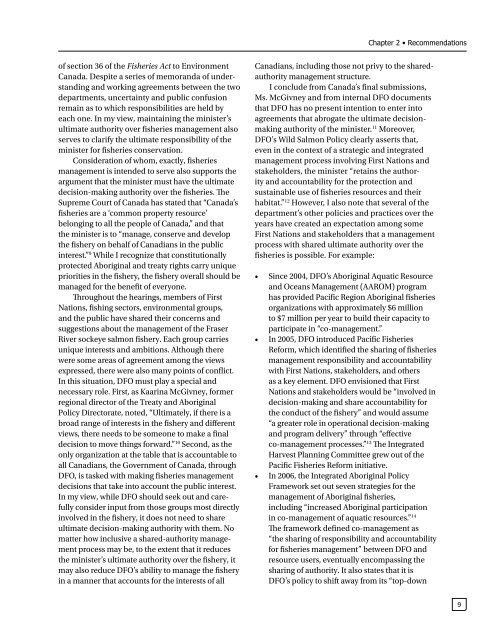CP32-93-2012-3-eng.pdf
CP32-93-2012-3-eng.pdf
CP32-93-2012-3-eng.pdf
You also want an ePaper? Increase the reach of your titles
YUMPU automatically turns print PDFs into web optimized ePapers that Google loves.
Chapter 2 • Recommendations<br />
of section 36 of the Fisheries Act to Environment<br />
Canada. Despite a series of memoranda of understanding<br />
and working agreements between the two<br />
departments, uncertainty and public confusion<br />
remain as to which responsibilities are held by<br />
each one. In my view, maintaining the minister’s<br />
ultimate authority over fisheries management also<br />
serves to clarify the ultimate responsibility of the<br />
minister for fisheries conservation.<br />
Consideration of whom, exactly, fisheries<br />
management is intended to serve also supports the<br />
argument that the minister must have the ultimate<br />
decision-making authority over the fisheries. The<br />
Supreme Court of Canada has stated that “Canada’s<br />
fisheries are a ‘common property resource’<br />
belonging to all the people of Canada,” and that<br />
the minister is to “manage, conserve and develop<br />
the fishery on behalf of Canadians in the public<br />
interest.” 9 While I recognize that constitutionally<br />
protected Aboriginal and treaty rights carry unique<br />
priorities in the fishery, the fishery overall should be<br />
managed for the benefit of everyone.<br />
Throughout the hearings, members of First<br />
Nations, fishing sectors, environmental groups,<br />
and the public have shared their concerns and<br />
suggestions about the management of the Fraser<br />
River sockeye salmon fishery. Each group carries<br />
unique interests and ambitions. Although there<br />
were some areas of agreement among the views<br />
expressed, there were also many points of conflict.<br />
In this situation, DFO must play a special and<br />
necessary role. First, as Kaarina McGivney, former<br />
regional director of the Treaty and Aboriginal<br />
Policy Directorate, noted, “Ultimately, if there is a<br />
broad range of interests in the fishery and different<br />
views, there needs to be someone to make a final<br />
decision to move things forward.” 10 Second, as the<br />
only organization at the table that is accountable to<br />
all Canadians, the Government of Canada, through<br />
DFO, is tasked with making fisheries management<br />
decisions that take into account the public interest.<br />
In my view, while DFO should seek out and carefully<br />
consider input from those groups most directly<br />
involved in the fishery, it does not need to share<br />
ultimate decision-making authority with them. No<br />
matter how inclusive a shared-authority management<br />
process may be, to the extent that it reduces<br />
the minister’s ultimate authority over the fishery, it<br />
may also reduce DFO’s ability to manage the fishery<br />
in a manner that accounts for the interests of all<br />
Canadians, including those not privy to the sharedauthority<br />
management structure.<br />
I conclude from Canada’s final submissions,<br />
Ms. McGivney and from internal DFO documents<br />
that DFO has no present intention to enter into<br />
agreements that abrogate the ultimate decisionmaking<br />
authority of the minister. 11 Moreover,<br />
DFO’s Wild Salmon Policy clearly asserts that,<br />
even in the context of a strategic and integrated<br />
management process involving First Nations and<br />
stakeholders, the minister “retains the authority<br />
and accountability for the protection and<br />
sustainable use of fisheries resources and their<br />
habitat.” 12 However, I also note that several of the<br />
department’s other policies and practices over the<br />
years have created an expectation among some<br />
First Nations and stakeholders that a management<br />
process with shared ultimate authority over the<br />
fisheries is possible. For example:<br />
• Since 2004, DFO’s Aboriginal Aquatic Resource<br />
and Oceans Management (AAROM) program<br />
has provided Pacific Region Aboriginal fisheries<br />
organizations with approximately $6 million<br />
to $7 million per year to build their capacity to<br />
participate in “co-management.”<br />
• In 2005, DFO introduced Pacific Fisheries<br />
Reform, which identified the sharing of fisheries<br />
management responsibility and accountability<br />
with First Nations, stakeholders, and others<br />
as a key element. DFO envisioned that First<br />
Nations and stakeholders would be “involved in<br />
decision-making and share accountability for<br />
the conduct of the fishery” and would assume<br />
“a greater role in operational decision-making<br />
and program delivery” through “effective<br />
co-management processes.” 13 The Integrated<br />
Harvest Planning Committee grew out of the<br />
Pacific Fisheries Reform initiative.<br />
• In 2006, the Integrated Aboriginal Policy<br />
Framework set out seven strategies for the<br />
management of Aboriginal fisheries,<br />
including “increased Aboriginal participation<br />
in co-management of aquatic resources.” 14<br />
The framework defined co-management as<br />
“the sharing of responsibility and accountability<br />
for fisheries management” between DFO and<br />
resource users, eventually encompassing the<br />
sharing of authority. It also states that it is<br />
DFO’s policy to shift away from its “top-down<br />
9
















